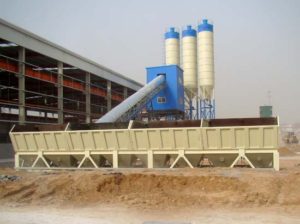Yes. There are lots of different types of concrete plants. They can be classified by what they are producing concrete for, the hourly production, the way the proportion materials and even the way they are constructed. First, it is important to know that concrete plant can be considered any machine that proportions the materials for concrete and then moves the materials to a mixer. Some concrete plants like precast, paving, and central mix include a mixer as part of the plant, while other concrete plants like ready-mix will use a mobile mixer usually mounted on a truck. Small contractors or users of concrete will frequently use a small drum mixer and shovel materials into it; this is not a concrete plant, just a mixer being fed manually.

I will briefly cover each of the major types of concrete plants, but this is a broad topic and will be impossible to cover in this brief article.
1. Weighing or Volumetric – A concrete batch plant usually refers to a concrete plant that weighs materials then conveys them to the mixer, while a volumetric proportions the material by volume. A concrete plant using weight is very common and provides the greatest accuracy and control over the concrete being produced. Volumetric plants are popular because of their small footprint and ability to mount on the back of a truck. Volumetric concrete plants are normally used for small production and may not be as accurate because sticky, wet, dry and other material variance may impact the mix quality.
2. Ready-Mix, Precast, Paving and Central Mix concrete plants – Each of these terms are normally used to refer to a concrete batch plant, or concrete plant using scales. A ready-mix or transit mix plant is a concrete plant that weighs materials and moves them to a truck to be mixed in transit to the job site. A precast plant is equipped with a plant mixer and normally makes smaller quantities of concrete for use at factories that use the concrete for their products. A Central mix or Paving plant is a concrete plant with high production and large batches usually discharging premixed concrete into a dump truck or concrete truck for use.
3. Portable or Stationary – Some plants are designed to be moved, while other are designed to be used at a single location. When considering a portable concrete plant it is important to look at the full level of portability. Some manufacturers manufacture plants that are mounted on a truck, while other have a higher production with semi-trailer modular plants, and other require multiple truck loads and take days to setup. Stationary plants can certainly be moved, but there is normally an additional amount of electrical and plumbing to be completed.
4. Production Rate – Some concrete plants produce lots of concrete while other are small. The price high production concrete plant can be as high as 10x+ more than the price of a small low production plant depending on various features.
5. Conveying Type – Not only can different concrete plants proportion materials differently, they can also convey them to the mixer differently. Most modern concrete plants use belt conveyors, skip hoists and augers. Some plants, however, use bucket elevators, drag lines, air slides or other means to move the materials.
While the information above represents some of the primary types of concrete plants it is important to remember there are lots of factors to consider when buying a plant.